Visit Report 2018
[Source: Helen Doery]
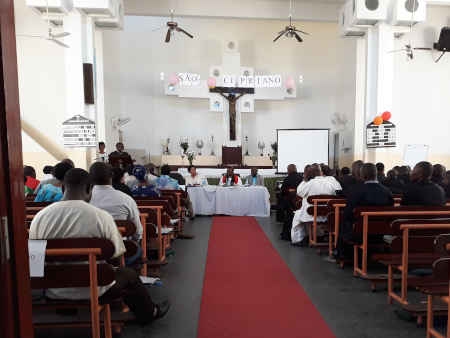
Martin How and I arrived at St Cyprians when Synod was in full swing of Day 1. We were given copies of the proceedings and outlines of the services, in Portuguese. This was the first time that Catechists and Church Wardens had been invited to participate, as Bp Carlos explained, ‘they are the people running the congregations’. Topics being discussed were very similar to our synod with the added problem of maintaining an adequate number of functioning Diocesan vehicles. Discussion groups on the following topics were held
Later that afternoon both Revd. Carla Vicencio Prior (MANNA) and I were asked by Bp Carlos to give presentations to explain the aims and rôles of MANNA and ALMA as there was confusion amongst the clergy. This was followed by a rousing talk from the Revd John Folts from Connecticut who read out letters from both his Bishop and Archbishop Michael Curry. The gift from London Diocese/ALMA of a thurible with boat and spoon was presented and greeted with great enthusiasm. (It was then used at the main celebration service on the Sunday.)
Recent decisions and actions made in the diocese, including those made by Synod were
We were privileged to be witnesses of the formation of the new entity ‘The Anglican Church of Mozambique’. All current and future Mozambican dioceses will come under this umbrella which has its own Canon Law. The gathering consisted of the Bp Carlos, Lebombo, Bp Vicente, Niassa, and Bp Manuel, Missionary Diocese of Nampula, church legal officers, Bp Alan, Pretoria and other invited visitors. Bp Carlos was elected President of the Permanent Commission and Bp Vicente as Vice-President, plus three other members.
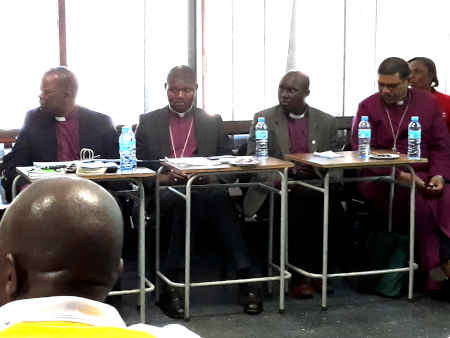
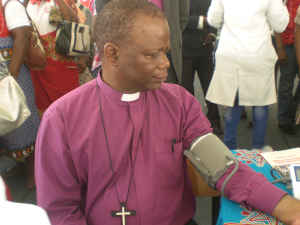
This was a most inspiring day; the activities and celebrations being held in St Cyprian’s School next to the Diocesan Centre. In the morning a ‘Health Fair’ had been arranged and anyone could have free health care and treatment carried out by the Health Professionals present in the following areas: blood pressure and blood sugar testing, family and paediatric advice, dental, optical, dietary advice, hygiene, nutrition, and a government official for the renewing, or issuing of, ID cards for those whose children had not been registered.
Later in the afternoon people gathered to hear Bp Carlos and other church leaders speak on ‘where we have come from’, ‘where are we now and how are we doing’ and ‘where are we going’. Bp Carlos encouraged all in their vision and values.
Vision to build a community of Christians who live in the power of Christ and the Holy Spirit in service to others, and to worship Christ in Spirit and in truth; all are called to know that truth in their lives, being living examples of this in the world.
Values: a) to live in respect for others as members of the same family, for without this there won’t be peace; and b) transparency. All need to be involved not just the Bishop or the clergy.
He later spoke about the need for all to develop their spirituality; to turn learning into actions and behaviour, deepening each one’s knowledge of the Word of God by daily reading and study resulting in spiritual growth, evangelisation and pastoral care. He encouraged all to belong to prayer groups so they would be believers who know the Way and help one another.
Many other groups within the church e.g. Mothers Union, Bernard Mizeki, ASA (Anglican Social Action), Youth, Children, Chaplaincy for the Elderly all followed speaking to the same agenda. The following is a sample of those groups.
Mothers Union: gave thanks for where they were now.
Rôle- to support the family to grow in unity and in the church. They had 2,800 members.
Vision- to grow but not just in numbers. There was a need to look at our families, then our church. Task - to see what they could do for their society, especially to help those who had been raped or suffered abuse.
Bernard Mizeki: Average age 40 years.
Objectives – evangelise, bring more fathers to know the Lord
Membership – currently 165 – need to encourage more to join. They are worried that there are not many men participating in church. They have a social side but also need to grow spiritually first, and also financially. Going forward – to work harder.
Children: need a lot of support from the MU and Bernard Mizeki groups because if these groups are weak then the children will be weak and they are the majority in the church. There have been training days for teachers and all Sunday Schools use the same programme throughout the diocese. They need well trained teachers and clergy committed to this and have just increased the number of chaplains.
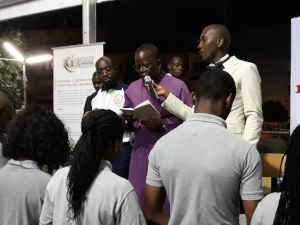
Youth: aged between 16 – 23 years. There are about 900 youth engaged across the six Episcopal Areas. About twelve youth were commissioned by Bp Carlos into positions of leadership as head of various sections of their work. A new Head of Youth was also appointed. Their aim was to reach out to more of the youth who didn’t go to church. Within the church they are considered ‘the salt of the church’ (and this was clearly obvious).
Anglican Social Action: - it’s for others, not ourselves. Currently working with lay people and clergy, training and helping to envision the diocese. They build slowly in order to increase understanding to achieve good quality groups. Their aim is to help one another with gender issues, food and nutrition and try and involve everyone. They are trying increase self-sufficiency and are looking towards creating a social fund.
The Blessing of the Seeds: The talks were followed by Bp Carlos and Bp Alan blessing a number of bags of ‘seeds’ – maize, ground nuts and others I couldn’t recognise. Following the blessing anyone was able to come and take as many ‘seeds’ as they could gather, to plant when the rains came.
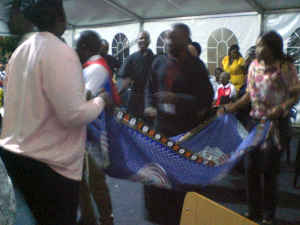
The partying followed this. There was an excellent band and singers composed of the youth; much partying, dancing, and socialising followed. One fascinating event was KKT – when members of each episcopal area danced ‘Conga’ style around the marquee where we were, and dropped monetary contributions into a capulana held by two people, the idea being that no-one would know if you were able to contribute a lot or a little. I never found out precisely what the money went to (I assumed the costs of the evening) but there was competition between the various episcopal areas. Despite our age we were readily included in the dancing by the youth. We left at about 10pm but celebrations, choirs singing etc continued into the night.
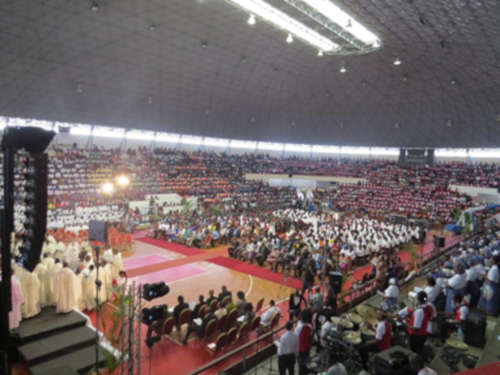
This was held in the Basketball Stadium at Maxaquene. 7.30am saw us seated in the second front row on the floor of the stadium. Already the raised section was full of choirs, Sunday School children etc. Everyone had their place. The stadium was decorated beautifully; those ushering had dresses in the same material but of their own design as did those taking up the offering. Each person’s role was clearly understood by their dress. The choir all wore 125th Anniversary capulanas and matching tops. From 8.20am onwards different groupings processed in with the President arriving just prior to all the clergy for a 9am start. All this time the choir had been singing. Throughout the service the youth and children had a significant profile. Everyone was welcomed, by episcopal area, by a six year old and there was a most expressive ‘play’ enacted by the children of a church primary school. The first reading again was done by a very young child. It was a joyous celebration with hymns sung in five different languages, including one in English, so all were included. Bp Carlos did the final closing of Synod and the Bishop of Pretoria Bp Alan gave the main address. The President gave a speech about the place of the Anglican Church in the history of Mozambique then both he and his wife were given gifts and he and his entourage left at about 11am. The service continued with Holy Communion and greetings from other Bishops and Communions interspersed with much singing and dancing. The service concluded at about 1.30pm. It truly was a celebration worthy of 125 years of the Anglican Church in Mozambique.
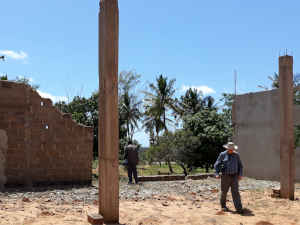
This is my link parish and we visited for an 8am mass on a Tuesday morning. Fr Micaias told the people about the celebrations especially as the daughter of one of the congregation was the six year old who read the first lesson. Sadly there was a power cut on the Sunday so none of them saw the TV broadcast of the whole service. We exchanged gifts and then went to look at the partially built church which was badly damaged in the 2017 cyclone. Half the front wall had collapsed. Funding is needed to complete the building and various suggestions were made about selling some land to a neighbour on the condition that they completed the building. These proposals have not come to fruition.
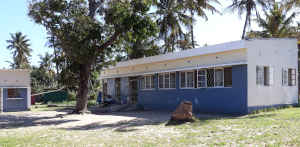
ALMA had given money for the Nursery School so I photographed the new building, the roofing, kitchen, water supply, toilets etc that had been done with the money sent. The nursery seemed to have very few resources for the children and they were hoping for provision for that.
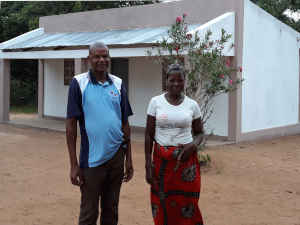
Fr. Tomas Chiponde and the voluntary Nursery Teacher greeted us and showed us the new Nursery School with its three small tables and four small plastic chairs for the children. It also has a small toilet block. Again resources for the children were minimal. They had pictures/charts around the walls. They have about 15 children and would like more tables and chairs, educational toys and pigs (for a start-up income generation scheme.)
There is already rain water harvesting from church into a large tank which hasn’t been full in 12 years. If they chose to harvest from the Nursery School they could feed into that.
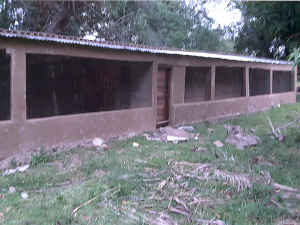
Again ALMA gave money for the nursery school here. Chicken sheds have been built for keeping day old chicks. They keep them for four weeks, sell them, then run a second cycle 14 days later so that it runs continuously giving a steady income. The sisters at the centre will look after them. The Nursery School is in a round building (couldn’t see any windows) and 25 children attend.
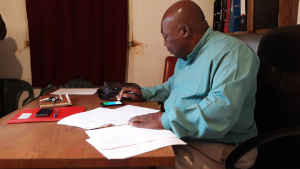
Fr Rogerio was there to greet us and the place looked really well kept. Ivan our Link Officer) noticed quite a bit of change since he was last there. The main business here was to sign the Vehicle Agreement for a Tuk-tuk to be bought with the money sent by their link parish, St Thomas, Finsbury Park. This would enable Fr. Rogerio to travel there more efficiently, as he lives some distance away until the priest’s house is improved.
Fr Rogerio was baptised there, was a deacon there and now is back there as priest. He built a house on the site when he was there as deacon, that they now want to use as a nursery school. They have collapsed a building made of zincs and intend using the good sheets on the house. The church roof has been replaced with painted zincs.
Bp Carlos said the priest’s house needs to be upgraded by improving the roofing, putting in an internal kitchen and bathroom with toilet. They also want to build a hall for the church and the community on the site where previously the house of zincs stood. They also have a deep well and want a pump for that so they can sell water as it is quite an issue in that area. Priorities have been discussed with their link parish.
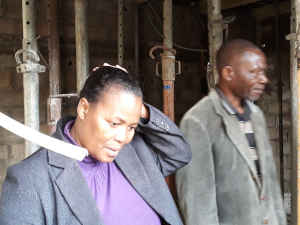
There is greatly improved signage from the main road and the end of the street. The building of the priest’s house is progressing well. £250 had recently been sent from their link parish of St Paul, Bow Common. They had just poured the floor for the second storey. There will be kitchen, bathroom, sitting room and office on ground floor and two bedrooms upstairs. They have made really good use of the small space available. They have also started installing very nice wooden benches with back support in the church. It has recently become classified as a pastoral zone instead of a Congregation as they are now financially viable. We met the catechist, treasurer, and a couple of other parishioners.
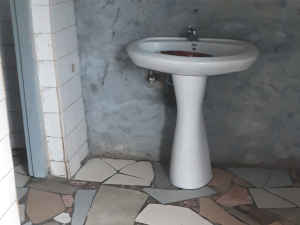
Fr Juan Ramirez is Mexican, is SSM as he teaches philosophy, and ethics in a higher education institute. He lives in his own house and lets out the priest’s house. The ‘water tank construction’ houses the office for the nursery school downstairs and the security guard upstairs. Currently the nursery school is making a loss so they are considering turning their main block into housing to let, with an added floor on top. They also would like to start raising chickens as they feel there is a good market for them locally. If this happens then the nursery school would revert to the three rooms beside the church with a room with beds for the children to rest (now a government requirement) and a kitchen down where they are now growing their own vegetables for meals for the school. We were shown the adult toilets where the floors had been paved and hand basin included using the money from their link parish of St John’s Greenhill (£500). We also saw inside the church where they have hung four curtains, one in the colour of each ecclesiastical season, against the wall behind the altar and there was smart new tiling on the floor. We then visited the children having lunch. We were also shown the new logo and the list of priests names on the end of the building and taken to the church office – beside the priest’s house – and were given some lunch, the same soup as the children and a roll.
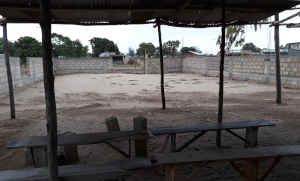
We met Fr Mateus Campira and saw the new church building, walls to about a metre, inside which is the wooden structure and benches currently being used as the church. Numbers are currently around 120. It reminded me of Influene. The builder is a church member and progress depends on when people are free to help. On the first Sunday in the month (when five congregations worship together) there is a collection for the building. When finished the church will be quite large with a very high roof. Ivan is very keen to find a link for this parish.
Bishop Carlos explained they were in the process of setting up an Anglican Theological Institute of Higher Education to be sited in a part of St Cyprian’s School that is currently rented out to a university. They are working with the Ministry of Education which endorses the idea of theological based higher education, especially due to the current lack of training for leaders in the increasing number and variety of churches in the country. It could also be used as a basis for training of other disciplines e.g. teachers and social workers and could train to degree level. It could be operational within six months and would also generate income.
Alongside this, plans for the first Portuguese speaking seminary in Africa, St Christopher’s Seminary at Madjuva, are continuing. It will train ordinands for ordained ministry from Angola and Mozambique, to Certificate and Diploma level. Ordinands could also attend the Anglican Theological Institute if they had the means to do so. Building at the Madjuva site will hopefully start soon but assurances of money given, or promised, are needed and Bishop Carlos is looking at ways to manage the high costs of construction, (currently estimated at US$ 1.3 million).
We had a final meeting with Bp Carlos when he explained their plans for Theological Training and the new Seminary. The Anglican Church in Lebombo is a church on the move with a clear strategy for growth – in depth of spirituality and Biblical knowledge, in practical expression of one’s faith, in the training of children and growing youth in responsibility, in each person knowing they are needed and essential to the church’s mission and in growth of income and numbers.
Bp Carlos was keen for us to know that all the celebrations were planned, arranged, funded and executed by the people. He oversaw the committees and co-ordinated it all but not a penny of Diocesan Funds was used.
It is a privilege to be a companion link with such a church. We have much to learn from them.
I am exceedingly grateful for the opportunity to have been present at these celebrations.